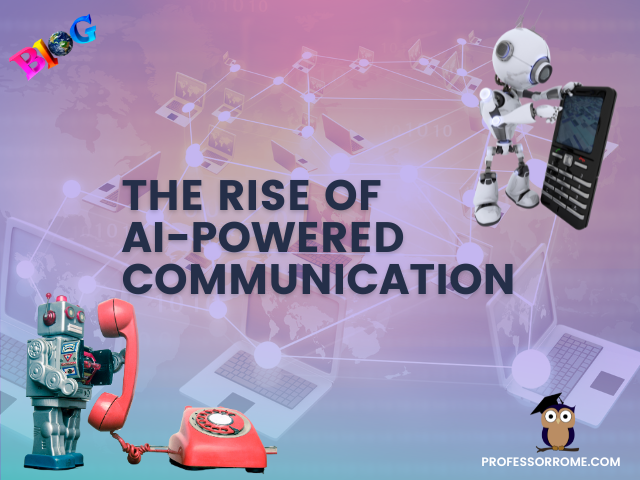
Have You Chatted with a Robot Today?
Ever message a company with a question and get an instant reply, even outside of business hours? Or maybe you use a voice assistant at home to set reminders or play music. Well, those are just a couple of examples of how AI, or Artificial Intelligence, is quietly taking over the world of communication!
That’s right, chatbots, virtual assistants, and even fancy email tools are using AI to transform the way businesses interact with us. But how exactly is this happening, and why should you care?

Let’s break it down. Imagine you’re on a company’s website and have a quick question about their product. Instead of waiting on hold for a customer service rep, you chat with a virtual assistant. This AI-powered program can answer your basic questions, troubleshoot common problems, and even point you in the right direction if your request is more complex. Pretty neat, right?
Here’s the real magic: AI can learn and adapt over time. The more people it interacts with, the better it gets at understanding questions and providing helpful answers. This means businesses can offer 24/7 customer support without needing a whole army of employees working nights and weekends. That’s a win-win for both sides!
But AI isn’t just about customer service. Businesses are also using it to personalize communication with employees. For example, an AI program might analyze an employee’s work habits and suggest relevant training materials. It can even send automated reminders about deadlines or company events.
So, what does this all mean for the future? Well, AI-powered communication is still in its early stages, but it’s clear that it has the potential to revolutionize the way we interact with businesses. Here are a few things to keep in mind:
- More natural interactions – AI chatbots are getting more sophisticated, and soon they might be able to hold conversations that feel almost human.
- Hyper-personalization – Imagine getting marketing emails or product recommendations tailored to your needs and interests. AI can make that happen!
- The human touch will still matter – Even with all the advancements in AI, human customer service reps will always be needed for complex issues or situations that require empathy and understanding.
A Balancing Act

We’ve seen how AI is making waves in the world of communication, with chatbots, virtual assistants, and other fancy tools taking center stage. But like any new technology, there are pros and cons to consider. Let’s dive into the advantages and disadvantages of this growing trend.
Advantages:
- Efficiency and 24/7 Availability – AI can answer basic questions, troubleshoot problems, and even schedule appointments, freeing up human reps for more complex issues. Plus, AI assistants never sleep, so businesses can offer around-the-clock customer support.
- Personalized Communication – AI can analyze data to understand customer preferences and tailor communication accordingly. Imagine receiving marketing emails or product recommendations that are relevant to you!
- Improved Employee Engagement – AI can automate tasks and send reminders, allowing employees to focus on more strategic work. It can also personalize learning and development opportunities for each employee.
- Cost Savings – Automating tasks with AI can significantly reduce customer service and communication-related costs for businesses.
Disadvantages:
- Lack of Human Touch – AI can’t replicate the empathy and understanding of a human customer service rep. For complex issues or situations requiring emotional intelligence, a real person is still irreplaceable.
- Job displacement – As AI automates tasks, some customer service and communication-related jobs may be lost.
- Bias and Discrimination – AI algorithms are only as good as the data they’re trained on. Biased data can lead to discriminatory outcomes in AI-powered communication. For example, an AI recruiting tool might unintentionally favor certain candidates based on factors unrelated to qualifications.
- Security Concerns – AI systems can be vulnerable to hacking, which could lead to data breaches and privacy violations.
Finding the Right Balance
While AI offers undeniable advantages, it’s important to be mindful of the potential drawbacks. The key is to find the right balance. AI should be used to enhance communication, not replace human interaction entirely. Here are some things to keep in mind:
- Transparency – Businesses should be transparent about their use of AI and how it’s being used to communicate with customers and employees.
- Human Oversight – Humans should always monitor AI systems to ensure they are functioning correctly and not perpetuating bias.
- Focus on Human Strengths – Use AI to free up human employees for the tasks they do best, like complex problem-solving and building relationships.
AI is a powerful tool, and it’s important to use it responsibly. By carefully considering the ethical implications and ensuring human oversight, AI can become a valuable asset in the communication landscape. As AI-powered communication continues to develop, it has the potential to make our interactions with businesses faster, easier, and more efficient. So next time you chat with a virtual assistant or get a perfectly timed reminder from your work platform, remember – you’re not just experiencing the future of communication, you’re part of shaping it. The future is likely to be a blend of human and artificial intelligence, and by embracing the advantages of AI while mitigating the risks, businesses can create a communication experience that’s both efficient and effective, benefiting both businesses and customers alike.



0 Comments